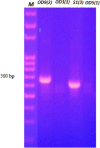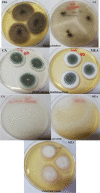First In Vitro- In Silico Analysis for the Determination of Antimicrobial and Antioxidant Properties of 2-(4-Methoxyphenylamino)-2-oxoethyl Methacrylate and p-Acetamide
- PMID: 38405536
- PMCID: PMC10882695
- DOI: 10.1021/acsomega.3c07836
First In Vitro- In Silico Analysis for the Determination of Antimicrobial and Antioxidant Properties of 2-(4-Methoxyphenylamino)-2-oxoethyl Methacrylate and p-Acetamide
Abstract
The antibacterial, antifungal, and antioxidant activities of 2-chloro-N-(4-methoxyphenyl)acetamide (p-acetamide) and 2-(4-methoxyphenylamino)-2-oxoethyl methacrylate (MPAEMA) were investigated by in vitro experiments and in silico analyses. MPAEMA has an antibacterial effect only against Gram-positive Staphylococcus aureus. It was determined that this did not affect any other bacteria and Candida glabrata yeast. On the other hand, p-acetamide showed antimicrobial activity against S. aureus ATCC 25923, C. glabrata ATCC 90030, Bacillus subtilis NRRL 744, Enterococcus faecalis ATCC 551289, Escherichia coli ATCC 25922, Klebsiella pneumoniae NRLLB4420, Pseudomonas aeruginosa ATCC 27853, and Listeria monocytogenes ATCC 1911. p-Acetamide showed the greatest antifungal effect by inhibiting the colony growth of Trichoderma longibrachiatum (98%). This was followed by Mucor plumbeus with 83% and Fusarium solani with 21%. MPAEMA inhibited colony growth of T. longibrachiatum by 95% and that of M. plumbeus by 91%. Also, p-acetamide and MPAEMA had a scavenging effect on free radicals. According to results of the in silico analysis, the antimicrobial effect of these compounds is due to their effect on DNA ligase. Based on drug-likeness analysis, they were found to be consistent with the Lipinski, Veber, or Ghose rule. p-Acetamide and MPAEMA may be used as drugs.
© 2024 The Authors. Published by American Chemical Society.
Conflict of interest statement
The authors declare no competing financial interest.
Figures












Similar articles
-
[Antimicrobial activity of soft and purified propolis extracts].Medicina (Kaunas). 2008;44(12):977-83. Medicina (Kaunas). 2008. PMID: 19142056 Lithuanian.
-
Chemical constituents of Helichrysum italicum (Roth) G. Don essential oil and their antimicrobial activity against Gram-positive and Gram-negative bacteria, filamentous fungi and Candida albicans.Saudi Pharm J. 2017 Jul;25(5):780-787. doi: 10.1016/j.jsps.2016.11.001. Epub 2016 Nov 12. Saudi Pharm J. 2017. PMID: 28725151 Free PMC article.
-
In vitro evaluation of new 2-phenoxy-benzo[g][1,2,4]triazolo[1,5-a]quinazoline derivatives as antimicrobial agents.Microb Pathog. 2018 Apr;117:60-67. doi: 10.1016/j.micpath.2018.02.018. Epub 2018 Feb 9. Microb Pathog. 2018. PMID: 29432912
-
Investigation of the antimicrobial activity of Rhaponticum (Rhaponticum carthamoides D.C. Iljin) and shrubby cinquefoil (Potentilla fruticosa L.).Medicina (Kaunas). 2011;47(3):174-9. Medicina (Kaunas). 2011. PMID: 21822040 English, Lithuanian.
-
Sulopenem: An Intravenous and Oral Penem for the Treatment of Urinary Tract Infections Due to Multidrug-Resistant Bacteria.Drugs. 2022 Apr;82(5):533-557. doi: 10.1007/s40265-022-01688-1. Epub 2022 Mar 16. Drugs. 2022. PMID: 35294769 Review.
References
-
- Zabiszak M.; Frymark J.; Ogawa K.; Skrobańska M.; Nowak M.; Jastrzab R.; Kaczmarek M. T. Complexes of β-lactam antibiotics and their Schiff-base derivatives as a weapon in the fight against bacterial resistance. Coord. Chem. Rev. 2023, 493, 21532610.1016/j.ccr.2023.215326. - DOI
-
- He Z.; Fan X.; Jin W.; Gao S.; Yan B.; Chen C.; Ding W.; Yin S.; Zhou X.; Liu H.; Li X.; Wang Q. Chlorine-resistant bacteria in drinking water: Generation, identification and inactivation using ozone-based technologies. J. Water Process Eng. 2023, 53, 10377210.1016/j.jwpe.2023.103772. - DOI
LinkOut - more resources
Full Text Sources
Molecular Biology Databases
